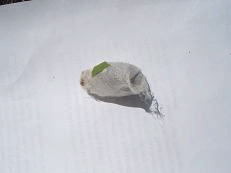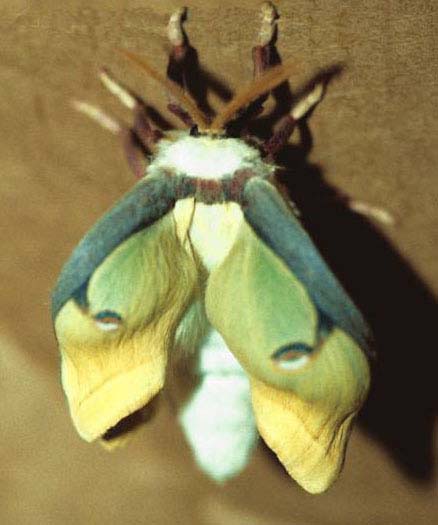Flying Insect #1: Luna Moth
with photos and information from <http://www3.islandtelecom.com/~oehlkew/zlunmoth.htm>
The Luna Moth, or Actias luna in the Linnean nomenclature, has a five-inch wingspan, lives in eastern North America, from Saskatchewan to Florida. Its incidence becomes less common as one moves westward, into the plains.
Actius Luna lives for a week or ten days, not having a mouth or any apparatus for feeding itself; the adult moth lives off fats stored from when they were caterpillars. Adult moths prefer to eat white birch, while larvae in southern climes have been known to favor persimmons. Interestingly, their color depends on the time of year in which they hatch: “Lunas which emerge in the spring often have a red lateral line on each side of the body and usually have narrow outer red margins on both fore and hind wings. This red colouration is absent from subsequent broods.”
To answer the questions posed in the brief:
The moths sense the world through their compound eyes, made of thousands of hexagonal lenses, good for sensing movement around them, and, more significantly, their sense organs, which are located in the antennae on top of their heads. The antennae help the Luna Moth smell, balance, and perhaps hear and touch things.
The moths fly using their two pairs of wings, which consist of membranous tissue supported by a network of veins. The coupling mechanism that holds the wings of the moths together in flight is a hook on the front part of the hind wing.
To be very honest, the reason why I chose this particular moth was the description of its eclosion, or emergence, that I read on the page cited above (a 15-second gif of a Luna Moth ecluding is included above):
“One of the most beautiful natural sights I ever witnessed as a young boy occurred one May morning when I chased an errant baseball into a mature hickory stand in New Jersey. Sunlight streamed through small openings in the leafy canopy onto lush ground foliage on the forest floor. A fully expanded, freshly emerged luna hung about one foot from the ground on the underside of a skunk cabbage stem. Despite having witnessed hundreds of eclosions in my lifetime, I still often pause to watch lunas eclose and inflate in emergence cages.”
That is, after the moths emerge from their cocoons, they inflate their wings by pumping fluid into the soft, stubby wings they have upon emergence while hanging from stems and tree trunks.
With regards to the moth’s attractions to light: the most captivating theory I read (on Wikipedia) is that “that moths use a technique of celestial navigation called transverse orientation. By maintaining a constant angular relationship to a bright celestial light, such as the Moon, they can fly in a straight line. Celestial objects are so far away, that even after travelling great distances, the change in angle between the moth and the light source is negligible; further, the moon will always be in the upper part of the visual field or on the horizon. When a moth encounters a much closer artificial light and uses it for navigation, the angle changes noticeably after only a short distance, in addition to being often below the horizon. The moth instinctively attempts to correct by turning toward the light, causing airborne moths to come plummeting downwards, and – at close range – which results in a spiral flight path that gets closer and closer to the light source.”
About this entry
You’re currently reading “Flying Insect #1: Luna Moth,” an entry on Austerity Games
- Published:
- September 7, 2008 / 8:37 pm
- Category:
- fifth ecology, insects, Uncategorized
- Tags:
- fifth ecology, insects




No comments yet
Jump to comment form | comment rss [?] | trackback uri [?]